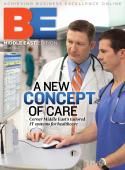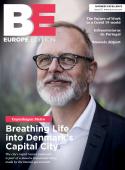An environment for healingKeith Regan learns how Altru Health SystemÔÇÖs decision to focus on patient comfort and aesthetics when it renovated and expanded its Cancer Center resulted in a place where patients and families can feel comfortable as they undergo their often lengthy treatments.┬á┬á Altru Health System provides health services to parts of northeast North Dakota and northwest Minnesota, with 1.5 million square feet of facilities space on its medical park campus. Much of that hospital and medical care infrastructure dates from 30 years ago or more, and the organization is systematically renovating space with an eye toward providing more patient comfort and aesthetic appeal. The project that best exemplifies that philosophy is the soon-to-be-completed $3.75 million renovation of the Altru Cancer Center in Grand Forks, North Dakota. The project not only modernized the Center and added technological capabilities such as a permanent PET/CT scan machine; it also focused heavily on patient comfort, a decision that the system made even though it meant additional costs, says Leah Hummel, facilities architect at Altru. ÔÇ£We could have done it a lot less expensively if we hadnÔÇÖt added the amenities we did,ÔÇØ she says. ÔÇ£But thatÔÇÖs part of the strategic plan.ÔÇØ Data collected by the Center for Health Care Design suggests patients heal and recover faster in environments that are more comfortable and less institutional than traditional hospital ward settings. And Nancy Klatt, manager of the Cancer Center, says the way oncology has evolved in recent decades has meant that patients often spend more time in treatment over a longer period of time than ever before. ÔÇ£Some patients come back for years and years, and as they come back, itÔÇÖs important that they have a place where they feel comfortable and thatÔÇÖs as attractive as it can be,ÔÇØ Klatt says. ÔÇ£Having a place that is aesthetically beautiful canÔÇÖt help but make it easier to come back than if they had to return to a bland or institutional building.ÔÇØ The renovated facility seeks that homey, comfortable touch with both large and small features. The waiting room and patient treatment areas alike feature windows that look out over landscaping specifically designed for the Cancer Center, with flowers and shrubs that bloom in the colors associated with the efforts to eradicate various cancersÔÇöpink for breast cancer, for instance. The waiting area features comfortable furniture and fireplaces to help warm patients against the long northern winters. The chemotherapy treatment areas themselves may be the biggest change in the facility. Rather than the ward-style approach, where all chemotherapy treatment stations are open to one anotherÔÇöan approach that would have been far less costly to build and operateÔÇöthe facility now has the capacity to treat 21 patients in 16 private or semi-private rooms. Klatt says the decision was made to enable rooms to be opened to one another because many patients return for treatment with others going through the same experience. ÔÇ£There is a social element that makes it easier for some people,ÔÇØ she adds. Each treatment space features state-of-the-art chemotherapy chairs, a personal flat-screen television, and windows and artwork breaking up the treatment areas also helps with infection control, notes Klatt. Natural lighting during the day is complemented by ambient lighting both outside and inside the facility at night. AltruÔÇÖs facilities manager Dan Beauchamp says the changes are reflected on the outside of the building as well, where the Cancer Center, once tucked in among other buildings on the medical campus, is now prominently featured, with a new canopied entranceway and more prominent signage. ÔÇ£The old Center was hidden away and hard to find, and now weÔÇÖve given it a greater presence on campus, which reflects the importance of the Center and the number of patients that weÔÇÖre treating now,ÔÇØ Beauchamp says. The renovationsÔÇöwhich included 14,000 square feet of new space in two separate additions and were carried out in four phases slated to be completed late in 2008ÔÇöalso allow operational changes, with all physicians and other medical oncology care providers brought together in a central workspace. Elsewhere at Altru, efforts are under way to modernize facilities, many of which date back 30 years or more. Ongoing work includes updating infrastructure such as air handling systems, plumbing and exterior brickwork, Beauchamp says. Another project involves converting the main floor of the primary hospital facility from mainly an inpatient setting to one that focuses mainly on outpatient care. ÔÇ£It has its challenges, because the building was designed to be used in that way, but weÔÇÖre trying to utilize the latest technology to make the facility as efficient as possible,ÔÇØ he adds. The Cancer Center building was originally designed as an orthopedic clinic but was remodeled in 2000 to be the first standalone cancer treatment center in the Grand Forks region. The original project was close to being put in motion in the late 1990s but had to be pushed back when the city of Grand Forks was devastated by spring flooding in 1997 and resources were diverted to more urgent projects. Since then, the delivery of chemotherapy as a cancer treatment option has vastly increased, creating a need for additional space for medical oncology. Over time, the medical community has more fully embraced the idea that aesthetics can assist in patient healing and treatment. Now the Cancer Center setting is poised to become a touchstone for future hospital work as well. Already Altru has renovated a facility focused on plastic surgery and dermatology into more of a medical spa type of setting, says Hummel, changes that have helped it compete with other businesses offering similar services. ÔÇ£I think there have been lessons learned here in terms of how providing some of these amenities has value that people can now see for themselves,ÔÇØ Hummel adds. Even though the Cancer Center isnÔÇÖt fully operational yet in its renovated space, hospital employees from throughout the system have taken tours and been impressed with the new delivery model and the focus on aesthetics. ÔÇ£People can see in bricks and mortar how the approach works, and that makes it more likely weÔÇÖll take that same approach again in the future.ÔÇØ









